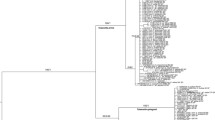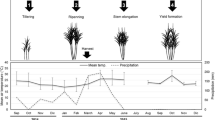Abstract
The ectomycorrhizal basidiomycete Tricholoma matsutake produces commercially valuable fruit bodies “matsutake” on a massive persisting rhizosphere aggregate of mycelia and mycorrhizas called “shiro.” Using inter-retrotransposon amplified polymorphism analysis, we attempted to explore the potential diversity within the population of T. matsutake isolated from small Pinus densiflora woodlands located in various parts of Japan. In general, random phylogenetic relationship was noted among T. matsutake tested. The population from each limited sampling area was highly heterogeneous. Even some isolates from fruit bodies produced in the same shiro and those from spores in the same fruit bodies were found to be genetically diverse, indicating the occurrence of genetic mosaics in shiro. In a mosaic shiro, heterologous genets produced their fruit bodies concurrently. Data suggested that the dispersal of spores through sexual reproduction may have been more prevalent than generally accepted in T. matsutake to bring mosaicism and coordination of heterologous genets within the shiro. Implementation of management taking such diversity into consideration is urgently needed for the restoration of devastated matsutake fields in Japan. Exploration of individual clones in mosaic fungal resources that promote colonization and fruit body production is necessary for it.




Similar content being viewed by others
References
Anderson IC, Chambers SM, Cairney JWG (1998) Use of molecular methods to estimate the size and distribution of mycelial individuals of the ectomycorrhizal basidiomycete Pisolithus tinctorius. Mycol Res 102:295–300
Baar J, Ozinga WA, Kuyper TW (1994) Spatial distribution of Laccaria bicolor genets reflected by sporocaps after removal of litter and humus layers in a Pinus sylvestris forest. Mycol Res 98:726–728
Babasaki K, Masuno K, Murata H (2003) Interactions of heterologous mycelia colonized in the substrate govern fruit body production in the cultivated homobasidiomycete Pholiota nameko. Biosci Biotechnol Biochem 67:100–106
Bonello P, Bruns TD, Gardes M (1998) Genetic structure of a natural population of the ectomycorrhizal fungus Suillus pungens. New Phytol 138:533–542
Buller AHR (1931) Research on fungi, IV. Longmans, Green and Co., London, pp. 1–329
Dahlberg A, Stenlid J (1990) Population structure and dynamics in Suillus bovinus as indicated by spatial distribution of fungal clones. New Phytol 115:487–493
Dahlberg A, Stenlid J (1994) Size, distribution and biomass of genets in population of Suillus bovinus (L.:Fr) Roussel revealed by somatic incompatibility. New Phytol 128:225–234
Dobinson KF, Harris RE, Hamer JE (1993) Grasshopper, a long terminal repeat (LTR) retroelement in the phytopathogenic fungus Magnaporthe grisea. Mol Plant-Microb Interact 6:114–126
Fukuda M, Fukumasa-Nakai Y (1996) Genetic evidence supporting the multicellular origin of fruiting body formation in the basidiomycete Lentinula edodes. Mokuzai Gakkaishi 42:1025–1028
Gherbi H, Delaruelle C, Selosse M-A, Martin F (1999) High genetic diversity in a population of the ectomycorrhizal basidiomycete Laccaria amethystina in a 150-year-old beech forest. Mol Ecol 8:2003–2013
Gryta H, Debaud JC, Effosse A, Gay G, Marmeisse R (1997) Fine-scale structure of populations of the ectomycorrhizal fungus Hebeloma cylindrosporum in coastal sand dune forest ecosystems. Mol Ecol 6:353–364
Hamada M (1970) Diaries on Armillaria matsutake (5). Trans Mycol Soc Jpn 11:81–86
Hamer JE, Farrall L, Orbach MJ, Valent B, Chumley FG (1989) Host species-specific conservation of a family of repeated DNA sequences in the genome of a fungal plant pathogen. Proc Natl Acad Sci U S A 86:9981–9985
Hornby JM, Jensen EC, Lisec AD, Tasto JJ, Jahnke B, Shoemaker R, Dussault P, Nickerson KW (2001) Quorum sensing in the dimorphic fungus Candida albicans is mediated by farnesol. Appl Environ Microbiol 67:2982–2992
Hosford D, Pilz D, Molina R, Amaranthus M (1997) Ecology and management of the commercially harvested American matsutake mushroom. USDA Forest service PNW-GTR412 pp 1–68
Kalendar R, Grob T, Regina M, Suoniemi A, Schulman A (1999) IRAP and REMAP: two new retrotransposon-based DNA fingerprinting techniques. Theor Appl Genet 98:704–711
Kumar A, Bennetzen JL (1999) Plant retrotransposons. Annu Rev Genet 33:479–532
Levy M, Romao J, Marchetti MA, Hamer JE (1991) DNA fingerprinting with a dispersed repeated sequence resolves pathotype diversity in the rice blast fungus. Plant Cell 3:95–102
Miller MB, Bassler BL (2001) Quorum sensing in bacteria. Annu Rev Microbiol 55:165–199
Murata H, Yamada A (2000) marY1, a member of the gypsy group of long terminal repeat retroelements from the ectomycorrhizal basidiomycete Tricholoma matsutake. Appl Environ Microbiol 66:3642–3645
Murata H, Babasaki K, Yamada A (2005) Highly polymorphic DNA markers to specify strains of the ectomycorrhizal basidiomycete Tricholoma matsutake based on σ marY1 , the long terminal repeat of gypsy-type retroelement marY1. Mycorrhiza (in press)
Ogawa M (1975) Microbial ecology of mycorrhizal fungus—Tricholoma matsutake (Ito et Imai) Sing. in pine forest. II. Mycorrhiza formed by T. matsutake. Bull Gov Forest Exp Station 278:21–80
Ohta A (1986) Basidiospore germination of Tricholoma matsutake (I). Effects of organic acids on swelling and germination of the basidiospores. Trans Mycol Soc Jpn 27:167–173
Peabody RB, Peabody DC, Sicard KM (2000) A genetic mosaic in the fruiting stage of Armillaria gallica. Fungal Genet Biol 29:72–80
Raper JR (1966) Genetics of sexuality in higher fungi. The Ronald Press Company, New York, pp. 1–283
Redecker D, Szaro TM, Bowman RJ, Bruns T (2001) Small genets of Lactarius xanthogalactus, Russula cremoricolor and Amanita francheti in late-stage ectomycorrhizal successions. Mol Ecol 10:1025–1034
Sawyer NA, Chambers SM, Cairney JWG (1999) Molecular investigation of genet distribution and genetic variation of Cortinarius rotundisporus in eastern Australian sclerophyll forests. New Phytol 142:561–568
Shimomura M, Yasue H, Ohshima N (1997) Molecular evidence from retroposons that whales from a clade within even-toed ungulates. Nature 388:666–670
Smith ML, Bruhn JN, Anderson JB (1992) The fungus Armillaria bulbosa is among the largest and oldest living organisms. Nature 356:428–431
Thompson JD, Gibson TJ, Plewniak F, Jeanmougin F, Higgins DG (1997) The Clustal X windows interface: flexible strategies for multiple sequence alignment aided by quality analysis tools. Nucleic Acids Res 25:4876–4882
Williams JGK, Kubelik AR, Livak KJ, Rafalski JA, Tingey SV (1990) DNA polymorphisms amplified by arbitrary primers are useful genetic markers. Nucleic Acids Res 18:6531–6535
Acknowledgements
This work was supported by a grant from the Ministry of Agriculture, Forestry and Fishery of Japan.
Author information
Authors and Affiliations
Corresponding author
Rights and permissions
About this article
Cite this article
Murata, H., Ohta, A., Yamada, A. et al. Genetic mosaics in the massive persisting rhizosphere colony “shiro” of the ectomycorrhizal basidiomycete Tricholoma matsutake. Mycorrhiza 15, 505–512 (2005). https://doi.org/10.1007/s00572-005-0358-1
Received:
Accepted:
Published:
Issue Date:
DOI: https://doi.org/10.1007/s00572-005-0358-1




